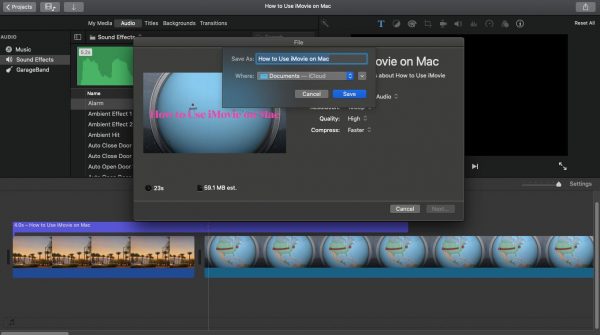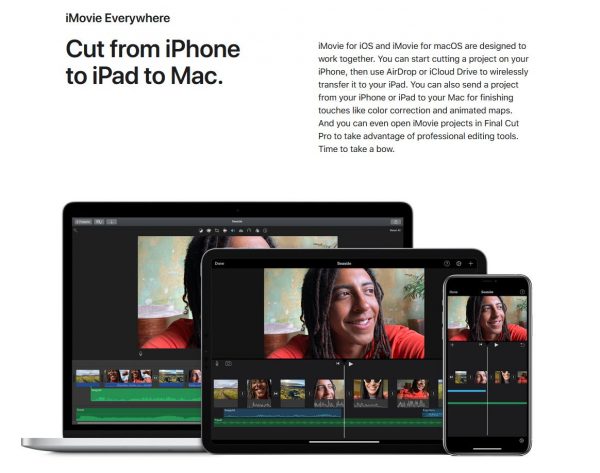What Is iMovie?
iMovie is Apple’s default video editor. It comes preinstalled on your Apple devices so all you have to do is launch it from your device to use it. The great thing about iMovie is you can create stunning videos using only photos but you can add videos to them as well. You can even add special effects and music to make them more impressive. You can create trailers, showcase your travel memories, and other precious moments in your life, and share them with your friends.
How to Use iMovie on Mac
It’s convenient to use iMovie because it is very intuitive. Most of the time, you can drag and drop items to add to your movie or video. It has all the essentials in a video editing app, but there are still a lot of features that most people aren’t aware of. Below are each of those features and extremely useful tips on how you can make the most of them.
Downloading and Installing iMovie on Your MacBook
As mentioned, iMovie comes preinstalled on your iPhones and Macbooks. But in case you have accidentally deleted it or for some reason, it’s not installed, here’s how you can download and install iMovie on your MacBook. This applies to both Mac laptops and desktop computers. Download iMovie
Creating a New iMovie Project
Importing Photos and Videos
There are several ways to add media to your iMovie. You can pull from your default Photos application, any media library from your Mac, or you can import them from external storage. On the left menu is your Project Media panel that gives you access to your media libraries and on the center pane, you can see Import Media that lets you get photos and videos from different folders. You can also transfer photos from your iPhone to your computer. If you import from your Photos Library, you can choose from your albums or you can go to All Photos so you can easily access the most recent ones. You will also see categories. Drag and drop the photos and video clips you want to include in the storyboard below. The storyboard is also called the Timeline. If you choose to import from a folder, you have to give permission for iMovie to access files from your Desktop. You will then see all the folders on your Mac. This is also where you can access your external drives. Open the folder from the popup window and select your media then click Import. By default, these photos and clips will be in the order in which they were imported. You can drag and drop each of them to arrange their location on the board.
Using the Ken Burns Feature
The Ken Burns feature is what makes iMovie unique from all other video editing apps. It allows you to add an effect to your photos such that they move from one direction to the next. You can also zoom in and out of photos. Take note that this feature only works for still photos. So how do you use Ken Burns for iMovie on a Mac?
Media Trimming and Splitting
You can trim and split a particular photo or video for enhanced effects. When is splitting useful? For example, you want to add subtitles on different parts of that particular media. You can split it so that the texts show separately. Trimming, on the other hand, can be useful if you want to time that particular slide with the music. You can use the trim tool to either prolong or extend the exposure of a photo or shorten it. Extending a video using the trim feature would loop it back to the beginning of the video is short. This is how you can use the split and trim features for iMovie on Mac. For both steps, make sure that on the right pane, you are in Cropping mode.
Trimming
Splitting
Combining Clips
Combining clips on iMovie does not mean that two photos or videos will become one. This is simply the process of putting two media next to each other in such a way that they appear connected. Or to make them display continuously. Drag and drop the clips you want to combine. To make it appear that two or more clips are one clip, you can remove any transitions between them.
Adding Transition Effects
iMovie’s transition effects are incredibly superior compared to other video editing apps. There are about 24 different transition effects available on iMovie on Mac, and they are so versatile. You can edit the duration of each transition and choose different types of transitions in between clips. The process of adding transitions on a Mac greatly differs from an iPhone. Here is how you can use transition effects on iMovie on Mac.
Adding Filters
You can add filters to both photos and videos. You can add it to an individual clip, the entire video, and to the background music as well.
Inputting Texts or Subtitles to Clips
Adding text to your videos creates an amazing effect. Your videos can look like professional trailers, and it’s a great way to tell stories. You can choose from several text fonts and layouts. Take note that texts or subtitles added to clips on iMovie only last for a few seconds. They will not stay on the screen for the whole duration of the clip but you can choose which location they start appearing. You can add subtitles for individual clips. This is how you can use the Subtitle feature on iMovie on a Mac.
Adding Fade to Black
For added effect, you may want your video or movie to fade in or fade out to black. It’s best to add this effect once you’re done editing your clips because you have to navigate out of editing mode to add it.
Enhance Your Movie: Adding Music to Your Video
You can add music either to individual clips or the entire movie. This part can be a little tricky because as you know, Apple makes it complicated to add your own music files to your device unless you’ve purchased them from iTunes. You may also want to be careful because if you use music from popular artists and you post your iMovie video on social media, it may be flagged for copyright infringement. Below are the best ways to add music to your videos.
Muting Original Video Sounds
If you’ve added video clips as part of your iMovie project, you may not want the original audio to be audible, especially if you’re adding music to it.
Default Theme Soundtracks
We’ve mentioned earlier that iMovie has themes that you can choose from. These are not to be confused with templates. iMovie only offers templates to Trailers. There are a few iMovie themes that you can use, like the News Theme for example. Using this will apply breaking news-like music and transitions to your video. If you want to use that particular music, you can select that Theme and toggle on Theme Music. The music will automatically be applied.
From Your iTunes Library and Garageband
You can import music to iMovie that you have saved to your iTunes Library as well as from Garageband—if you have it installed. Garageband is Apple’s sound editing software.
From the Free Soundtrack Library
iMovie offers plenty of free soundtracks that you can use for your videos. You will not be flagged for copyright infringement even if you post them on social. Here is how you can use the free soundtrack library on iMovie on a Mac.
Saving Your Movie Projects and Videos
Once you are happy with your movie, you can now save your project and your video. Saving your iMovie project does not automatically convert it to a video file. It only means that it will be saved so you can edit it later if you want. You have to export your video for it to be available in your libraries and folders. First, save your project by clicking on My Projects, which is the first option on the top menu. You will see a popup where you can enter a filename for your iMovie project. Once you click OK, your project will be saved and you will be redirected to the screen where you will see all your iMovie projects.
Saving Your Video
There are different ways to save or export your iMovie to a video format.
Knowing the Video Format
When you export your iMovie project into video format, it will be saved as mp4. You can choose the quality or resolution of the video from 1080p, and below but you need to do this before saving it.
Where to Find Your New Video
We’ve mentioned in the steps above that you can choose the folder where you want your video to be saved. But some might be confused because on iPhones, exporting a video from iMovie directly saves it to your Photos Library. This is not the case when you use iMovie on a Mac. On a MacBook, your video will only be initially saved on the folder you’ve selected upon saving it.
How to Save It to Your Photos Library
So what if you want it on your Photos Library? Unfortunately, you can’t export it directly from your Mac. The best thing you can do is:
Sharing Your iMovie Video
Now that you’ve learned how to use iMovie on a Mac and have created a wonderful video, you can share it with your friends! You can share your video directly from your MacBook or you can follow the steps above and save it on your Photos Library then share it from your iPhone. To share from your Mac, you have to navigate to the folder where you’ve saved it and upload it directly to the social media site where you want to post it.
Why Use iMovie?
Using iMovie to create and edit videos makes telling stories a lot more fun and easier. It’s a great tool for artists and business owners to create marketing materials to showcase their products or works. If you have written a book, for example, you can create beautiful book trailers using iMovie. If you are starting a podcast, you can create a teaser for your podcast to encourage people to listen to you. You can use it for presentations at work or company events. You can also use it simply to share memories with friends and family.
Final Word
iMovie truly takes your video editing skills to the next level. You don’t need to be a professional to create stunning videos. It’s easy to use and best of all, it’s free! So master using iMovie on your Mac using the tips above and tell captivating stories now.
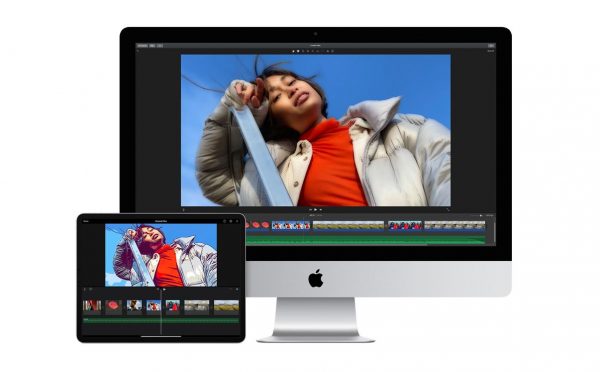

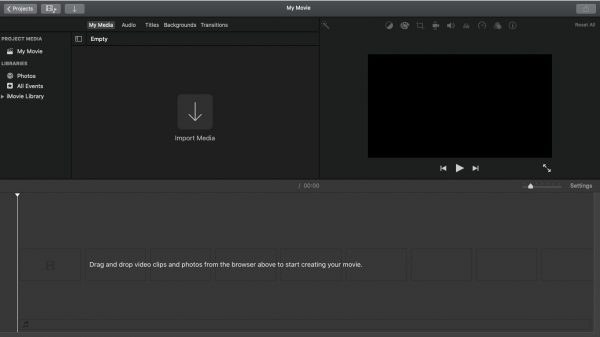
![]()
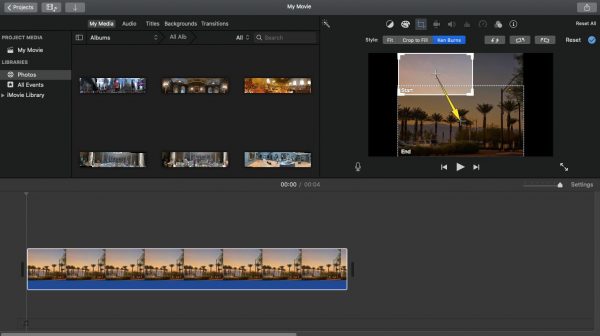
![]()
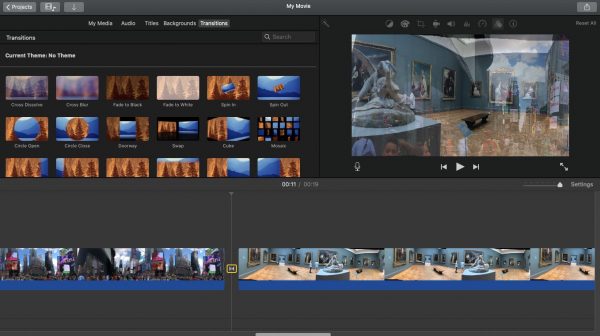
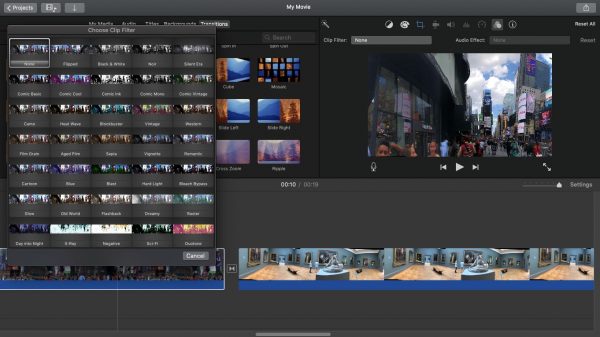
![]()
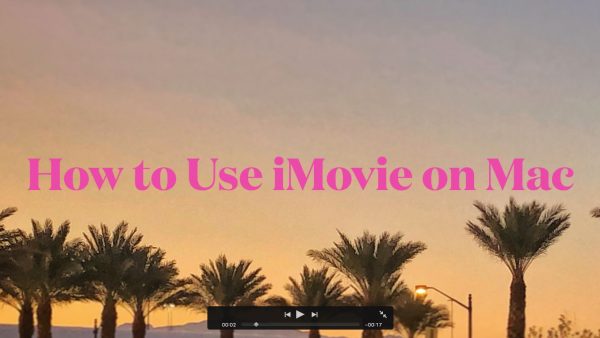
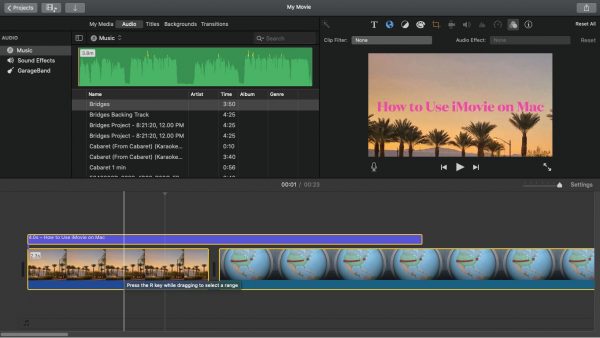
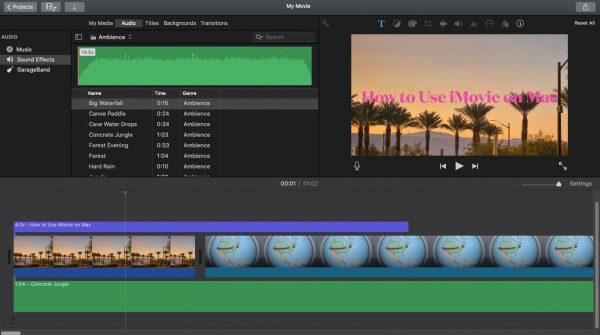
![]()
